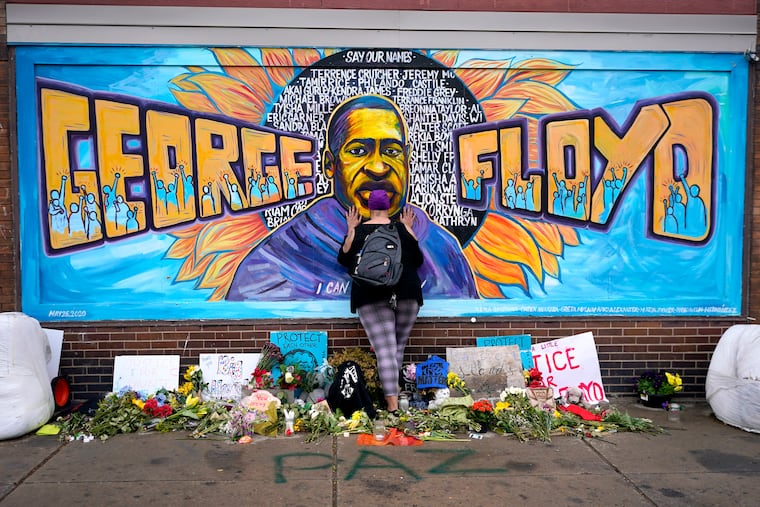N.J. mall arrest shows police bias is alive and well in post-George Floyd America | Jenice Armstrong
The common denominator in both the Bridgewater mall fight and the George Floyd events is the biased way that some police interact with those whom they are paid to serve.

As a federal jury in Minnesota weighs the fate of three of the police officers involved in the murder of George Floyd in 2020, an incident closer to home has me wondering if we’ve made any progress at all.
Earlier this month, two young men in North Jersey fought at a mall in Bridgewater, N.J. In cell phone video, you can clearly see two young men trade blows — one Black and one who appears to be white. At one point, they fall onto the floor, still struggling. The African American kid is on the bottom and losing. Seconds later, police rush in and immediately arrest one of them. Who do you think wound up handcuffed and in custody?
If you guessed the African American teen, then you’re correct.
Instead of treating both youngsters equally, police immediately identified the Black teen as the troublemaker. The other, who had been on top of the African American teen and getting the better of him, is treated as if he’s a victim and carefully escorted to a couch where he is left unattended as the two officers handcuff the Black teen. Then a female officer can be seen putting her knee on the Black youngster’s neck as the white teen watches.
I can’t stop watching the video, and every time I do, I get mad all over again. It’s a reminder of how far we haven’t come, despite the massive protests of 2020 and all the conversations about race we have had as a nation.
After video of Floyd’s murder went viral, the world responded. Millions of people took to the streets, calling for change — not only by law enforcement, but in every single aspect of American life. Some changes happened. Authorities in Minneapolis banned police from using chokeholds and neck restraints; Louisville did away with no-knock warrants. In a message to former Pres. Trump, Mayor Muriel Bowser renamed the street leading up to the White House Black Lives Matter Plaza.
Closer to home, officials removed the statue of former Mayor and Police Commissioner Frank Rizzo, who was known for aggressive tactics policing the Black and gay communities. The Philadelphia Inquirer turned its gaze inward and began taking steps to become actively anti-racist, and apologized for transgressions against African Americans. Philly announced, among other steps, a new Citizens Police Oversight Commission, which will replace the Police Advisory Commission and is designed to have more power and resources.
In many ways, though, that was an illusion. Some things never change. Which is why less than two years after George Floyd was killed, a Black teen in Bridgewater ended up handcuffed, face-down at a mall with a knee at his neck while a white teen got to sit on the couch and watch.
What happened at that mall is the most blatantly racist thing I have seen in a long time, and another reminder of why implicit bias training for law enforcement is so important. Even the other teen — who says he’s Colombian and Pakistani, not white — believes the cops’ actions were wrong.
“I don’t understand why they arrested him and not me,” he told NJ Advance Media last week. “I say that was just plain old racist. I don’t condone that at all ... I even offered to get arrested.”
Meanwhile, three Minneapolis police officers charged with violating George Floyd’s civil rights are on trial in federal court. Tou Thao, J. Alexander Kueng, and Thomas Lane are charged with depriving Floyd of his right to medical care, among other things, as convicted killer Derek Chauvin pressed his knee into Floyd’s neck for nine and a half minutes. Floyd lost his life as these three officers stood by and aided and abetted Chauvin.
“I definitely see a connection [between the Floyd killing and the Bridgewater fight],” said implicit bias expert Michele Ruiz, co-founder of BiasSync, which creates anti-bias training based on science. “Our biases are triggered in high-stress situations and that’s what played out in both situations.”
The common denominator in both these events is the biased way that some police interact with those whom they are paid to serve. There’s no excuse for the tactics used at the Bridgewater mall, where two boys, equally involved in the fight, were treated unequally by police officers.
An apology would be a start, as well as full transparency about errors made and steps taken to prevent a recurrence.
This is a fight that Black people have waged for years. The ways that Floyd and the youngster at the mall were treated are glaring reminders of what we are up against.